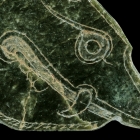J.J. Lally & Co., Oriental Art / New York City, New York
Menu75.
AN INCISED GREEN JADE DRAGON HEAD PLAQUE FRAGMENT
Han Dynasty (206 B.C. – A.D. 220)
the large head shown in profile, with the outline of the plaque delineating the pointed snout and clenched jaws, the surface highly polished on one side and vigorously incised and scraped to show various details including a large circular eye above a hooked fang emerging from the side of the mouth, a long ribbed horn curving down from behind the ear, and one foreleg ending in clawed foot held close under the chin, the reverse unfinished and plain, indicating the carving was probably used as an inlay, the dark moss green jade with remains of earth and cinnabar.
Length 6 3⁄4 inches (17.2 cm)
A similarly carved jade plaque in the form of a wild boar with incised details on the polished surface, excavated in 2002 from a tomb at Maopo, Chang’an, Shaanxi province, dated to the middle of the Western Han dynasty, is illustrated by Liu, Shaanxi chutu Han dai yuqi (Han Dynasty Jades Unearthed in Shaanxi), Beijing, 2009, p. 229, no. 197.
漢 龍首紋玉牌 長 17.2 厘米
